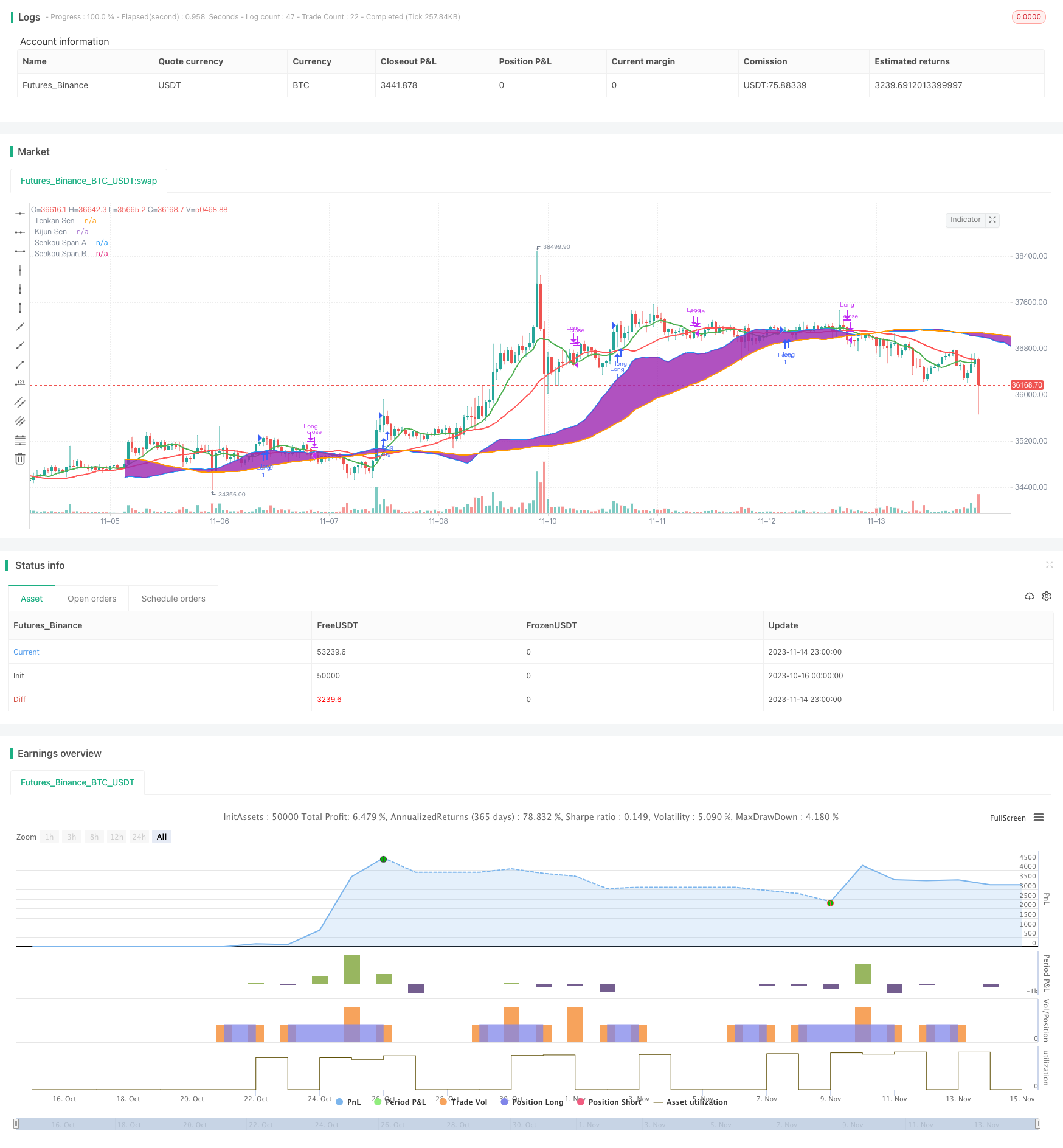
概述
本策略运用经典的一目均衡指标中转线和基准线构成的金叉、死叉信号,判断市场的趋势方向,以发现潜在的买入和卖出机会。当转线上穿基准线时,视为买入信号;当转线下穿基准线时,视为卖出信号。结合 Ichimoku 云图的先导Span B线判断长期趋势方向,可有效过滤掉部分不理想的交易信号。
策略原理
该策略主要基于以下几点原理:
一目均衡指标中的转线代表近期的价格动量,基准线代表中长期的价格走势。当转线上穿基准线时,代表近期动量强于中长期趋势,属于建仓的良好时机;反之,则代表需警惕平仓。
Ichimoku 云图的先导 Span B 线能够有效判断大盘长期趋势的方向。策略只在 Span B线的方向与交易信号一致时才发出交易信号。这能过滤掉部分与大趋势不符的交易机会,避免随机的交易风险。
结合转线与基准线的交叉信号和 Ichimoku 云图的判断,可以在大趋势向上的条件下捕捉中短期价格的强势反弹,实现超额收益。
当买入信号被触发后,若价格跌破云图的 Senkou Span A 或 Senkou Span B 线,说明中长期趋势发生变化,应及时止损平仓。
策略优势
本策略最大的优势在于:
一目均衡指标参数设置灵活,能够对不同周期的价格变动进行有效跟踪。
Ichimoku 云图判断大趋势的能力强,有利于避免随机交易。
转线与基准线的交叉系统简单清晰,容易判断和实现自动交易。
仅基于两个指标,实现了多时间维度的综合判断,不会产生假信号。
策略方式简单积极,适合追踪中短期强势反弹,可获较高收益。
策略风险
本策略的主要风险在于:
一目均衡指标对参数设置较为敏感,不同周期参数不当会产生错误交易信号。
存在一定的随机交易风险,中短期信号可能与大趋势不一致。
仅基于两个指标组合使用,存在切入点选择的局限性。
追涨杀跌的交易方式,可能带来一定程度的资金亏损风险。
存在一定的过优化风险,需要针对不同品种谨慎优化参数。
优化方向
本策略可以从以下几个方面进行优化:
测试不同的一目均衡指标参数组合,寻找最佳周期参数。
增加其他指标过滤信号,如 MACD、RSI 等,提高策略稳定性。
增加止损策略,如趋势线止损、移动止损等,控制风险。
优化仓位管理,根据市场波动程度动态调整仓位。
测试不同品种参数健壮性,防止过拟合。
采用机器学习算法自动优化参数,实现动态调整。
总结
本策略整合运用一目均衡指标和 Ichimoku 云图判断系统,实现了对中短期趋势的有效跟踪。策略方式简单清晰,易于实盘操作。但仍需注意参数优化、仓位控制等问题,降低交易风险。总体来说,本策略具有较高的盈利能力,值得进行试验与修正,以发掘其潜力。
/*backtest
start: 2023-10-16 00:00:00
end: 2023-11-15 00:00:00
period: 1h
basePeriod: 15m
exchanges: [{"eid":"Futures_Binance","currency":"BTC_USDT"}]
*/
//@version=5
strategy("Ichimoku Cloud Strategy", overlay=true)
// Define Ichimoku Cloud components
conversionPeriods = input(9, title="Conversion Line Periods")
basePeriods = input(26, title="Base Line Periods")
leadingSpanBPeriods = input(52, title="Leading Span B Periods")
displacement = input(26, title="Displacement")
// Calculate Ichimoku Cloud components
tenkanSen = ta.sma(close, conversionPeriods)
kijunSen = ta.sma(close, basePeriods)
senkouSpanA = (tenkanSen + kijunSen) / 2
senkouSpanB = ta.sma(close, leadingSpanBPeriods)
// Plot Ichimoku Cloud components
p1 = plot(tenkanSen, color=color.green, linewidth=2, title="Tenkan Sen")
p2 = plot(kijunSen, color=color.red, linewidth=2, title="Kijun Sen")
p3 = plot(senkouSpanA, color=color.blue, linewidth=2, title="Senkou Span A", offset=displacement)
p4 = plot(senkouSpanB, color=color.orange, linewidth=2, title="Senkou Span B", offset=displacement)
fill(p3, p4, color=color.purple, transp=30, title="Cloud")
// Define strategy conditions
enterLong = ta.crossover(tenkanSen, kijunSen) and close > senkouSpanA[displacement] and close > senkouSpanB[displacement]
exitLong = ta.crossunder(tenkanSen, kijunSen) or close < senkouSpanA[displacement] and close < senkouSpanB[displacement]
// Execute strategy
if (enterLong)
strategy.entry("Long", strategy.long)
if (exitLong)
strategy.close("Long")